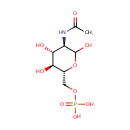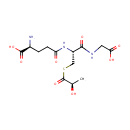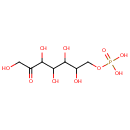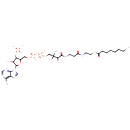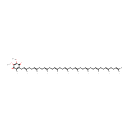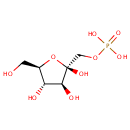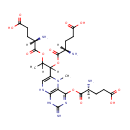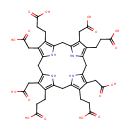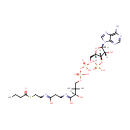
Search Results for compounds
Searching compounds for
returned 4373 results.
N-Acetyl-D-Glucosamine 6-Phosphate (PAMDB000238)
IUPAC:
{[(2R,3S,4R,5R)-5-acetamido-3,4,6-trihydroxyoxan-2-yl]methoxy}phosphonic acid
CAS: 102029-88-9
Description: N-Acetyl-D-Glucosamine 6-Phosphate is an intermediate in the metabolism of Aminosugars. It is a substrate for Glucosamine 6-phosphate N-acetyltransferase.
S-Lactoylglutathione (PAMDB000239)
IUPAC:
(2S)-2-amino-4-{[(1R)-1-[(carboxymethyl)carbamoyl]-2-{[(2R)-2-hydroxypropanoyl]sulfanyl}ethyl]carbamoyl}butanoic acid
CAS: 25138-66-3
Description: S-Lactoylglutathione is a substrate of lactoylglutathione lyase [EC 4.4.1.5] in pyruvate metabolism (KEGG). Another enzyme, glyoxalase I, synthesizes this compound by converting methylglyoxal and reduced glutathione to S-lactoylglutathione. S-D-lactoylglutathione can be hydrolysed by thiolesterases to reduced glutathione and D-lactate but also converted to N-D-lactoylcysteinylglycine and N-D-lactoylcysteine by gamma-glutamyl transferase and dipeptidase . S-lactoylglutathione has also been shown to modulate microtubule assembly .
D-Sedoheptulose 7-phosphate (PAMDB000240)
IUPAC:
[(2,3,4,5,7-pentahydroxy-6-oxoheptyl)oxy]phosphonic acid
CAS: 2646-35-7
Description: D-sedoheptulose 7-phosphate is a member of the chemical class known as Heptoses. These are monosaccharides in which the sugar unit is an heptose. D-sedoheptulose 7-phosphate is invovled in lipopolysaccharide biosynthesis, the pentose phosphate pathway (non-oxidative), the biosynthesis of secondary metabolites, the pentose phosphate pathway, and microbial metabolism in diverse environments. Sedoheptulose 7-phosphate is an intermediate in the pentose phosphate pathway. It is formed by transketolase and acted upon by transaldolase.
Octanoyl-CoA (PAMDB000241)
IUPAC:
{[5-(6-amino-9H-purin-9-yl)-4-hydroxy-2-({[hydroxy({[hydroxy({3-hydroxy-2,2-dimethyl-3-[(2-{[2-(octanoylsulfanyl)ethyl]carbamoyl}ethyl)carbamoyl]propoxy})phosphoryl]oxy})phosphoryl]oxy}methyl)oxolan-3-yl]oxy}phosphonic acid
CAS: 1264-52-4
Description: Octanoyl-CoA is a substrate for Acyl-coenzyme A oxidase, 3-ketoacyl-CoA thiolase, Acyl-CoA dehydrogenase, Acyl-coenzyme A oxidase and carnitine O-octanoyltransferase.
Ubiquinone-10 (PAMDB000242)
IUPAC:
2-[(2E,6E,10E,14E,18E,22E,26E,30E,34E)-3,7,11,15,19,23,27,31,35,39-decamethyltetraconta-2,6,10,14,18,22,26,30,34,38-decaen-1-yl]-5,6-dimethoxy-3-methylcyclohexa-2,5-diene-1,4-dione
CAS: 303-98-0
Description: Ubiquinone-10 is a member of the chemical class known as Polyprenylbenzoquinones. These are compounds containing a polyisoprene chain attached to a quinone at the second ring position. Ubiquione-10 has 10 isoprene units. Normally in Pseudomonas aeruginosa the active form of Ubiquinone has 8 isoprene units (Ubiquinone-8) and in humans it normally has 10. Ubiquinone-10 is an extended version of Ubiquinone 8 that arises from conjugation by an extended prenyl tail via 4-hydroxybenzoate polyprenyltransferase. Ubiquionone is involved in cellular respiration. It is fat-soluble and is therefore mobile in cellular membranes; it plays a unique role in the electron transport chain (ETC). In the inner bacterial membrane, electrons from NADH and succinate pass through the ETC to the oxygen, which is then reduced to water. The transfer of electrons through ETC results in the pumping of H+ across the membrane creating a proton gradient across the membrane, which is used by ATP synthase (located on the membrane) to generate ATP.
Fructose 1-phosphate (PAMDB000243)
IUPAC:
{[(2R,3S,4S,5R)-2,3,4-trihydroxy-5-(hydroxymethyl)oxolan-2-yl]methoxy}phosphonic acid
CAS: 15978-08-2
Description: Fructose 1-phosphate is an intermediate metabolite in the Fructose and mannose metabolism pathway. It is generated by fructokinase and it is broken down by aldolase B into glyceraldehyde and dihydroxyacetone phosphate (DHAP).
5-Methyltetrahydropteroyltri-L-glutamic acid (PAMDB000245)
IUPAC:
(4S)-4-amino-5-[(1-{[(2S)-2-amino-4-carboxybutanoyl]oxy}-1-(4-{[(2S)-2-amino-4-carboxybutanoyl]oxy}-2-imino-5-methyl-1,2,5,8-tetrahydropteridin-6-yl)propan-2-yl)oxy]-5-oxopentanoic acid
CAS: Not Available
Description: 5-methyltetrahydropteroyltri-L-glutamic acid is a member of the chemical class known as Biopterins and Derivatives. These are coenzymes containing a 2-amino-pteridine-4-one derivative.5-Methyltetrahydropteroyltri-L-glutamate is formed under reaction between carbonyl group of 5-methyltetrahydropteroate and amine group on one end of three replicates of glutamate. It is involved in several pathways such as tetrahydrofolate biosynthesis and methionine biosynthesis. (YMDB00518)
Uroporphyrinogen III (PAMDB000248)
IUPAC:
3-[9,14,20-tris(2-carboxyethyl)-5,10,15,19-tetrakis(carboxymethyl)-21,22,23,24-tetraazapentacyclo[16.2.1.1?,??1????.1??,???tetracosa-1(20),3,5,8,10,13,15,18-octaen-4-yl]propanoic acid
CAS: 1976-85-8
Description: Uroporphyrinogens are porphyrinogen variants in which each pyrrole ring has one acetate side chain and one propionate side chain; it is formed by condensation 4 four molecules of porphobilinogen. 4 isomers are possible but only 2 commoly are found, types I and III. Uroporphyrinogen III is a functional intermediate in heme biosynthesis while Uroporphyrinogen I is produced in an abortive side reaction.
Butyryl-CoA (PAMDB000250)
IUPAC:
(2R)-4-({[({[(2R,3S,4R,5R)-5-(6-amino-9H-purin-9-yl)-4-hydroxy-3-(phosphonooxy)oxolan-2-yl]methoxy}(hydroxy)phosphoryl)oxy](hydroxy)phosphoryl}oxy)-N-(2-{[2-(butanoylsulfanyl)ethyl]-C-hydroxycarbonimidoyl}ethyl)-2-hydroxy-3,3-dimethylbutanimidic acid
CAS: 2140-48-9
Description: Butyryl-CoA is a member of the chemical class known as Acyl CoAs. These are organic compounds contaning a coenzyme A substructure linked to another moeity through an ester bond. Butyryl-coenzyme A (or butyryl-CoA) is the coenzyme A-activated form of butyric acid. (WikiPedia)
Octaprenyl diphosphate (PAMDB000251)
IUPAC:
{[hydroxy({[(2E,6E,10E,14E,18E,22E,26E)-3,7,11,15,19,23,27,31-octamethyldotriaconta-2,6,10,14,18,22,26,30-octaen-1-yl]oxy})phosphoryl]oxy}phosphonic acid
CAS: Not Available
Description: Octaprenyl diphosphate belongs to the class of Tetraterpenes. These are terpene molecules containing 10 consecutively linked isoprene units. (inferred from compound structure)Octaprenyl diphosphate is invovled in Terpenoid backbone biosynthesis, Ubiquinone and other terpenoid-quinone biosynthesis, and Biosynthesis of secondary metabolites. (KEGG)
